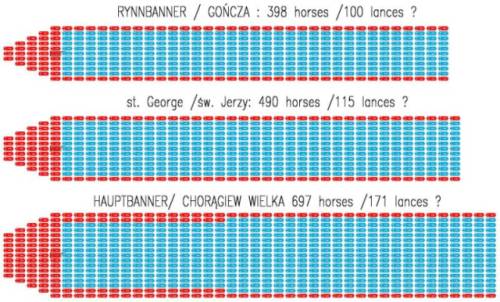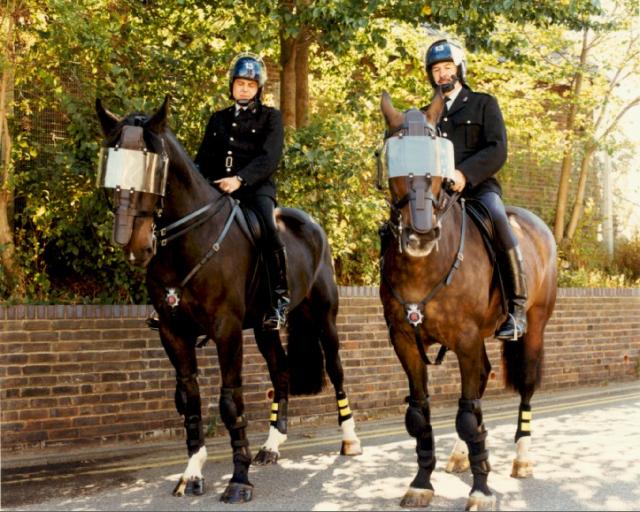1. What era we are talking
2. What specific country
Speaking from my country (Poland) perspective there are at least two "iterations" of heavy cavalry: the medieval knight and XVI-XVII-beginning of XVIII century hussar. While both are classified as heavy cavalry but there are major differences.
For Polish medieval heavy cavalry one major event is "Battle of Grunwald" (also known as first "battle of Tannenberg" or "battle of Stebark" in German sources, Žalgirio mūšis (Battle of Žalgiris) by Lithuanians), fought 15th of July, 1410. It was supposedly biggest horse army only battle in Europe. Written sources for this battle are: "Cronica conflictus Wladislai Regis Poloniae cum Cruciferis Anno Christi 1410"(Anonymus?) , Johann von Possilge: "Scriptores Rerum Prussicarum" (this two are supposedly written contemporaneously to the battle) , Jan Dlugosz (Joannes Longinus) : "Banderia Prutenorum" and "Annales" (written about 60 years after the battle), . I base following info on book by Andrzej Nadolski "Grunwald 1410" - seria "Historyczne Bitwy".
For long time it was assumed that this battle was fought with banners set in "picket fence" formations, where "lances" were just loose formations, roughly set in "line". This view is right now heavily contested, and polish historians think that battle was fought using banners in wedge-column formations, similar to ones desciribed in Branderburg chronicles from year 1477 (precise source is not stated). Generaly there are 3 "types" of banners described: Goncza (Rynnbanner), about 400 horses; sw. Jerzego (st. George), about 500 horses; Chorągiew Wielka (Hauptbanner, Great Banner), about 700 horses. Names from Branderburg chronicle correspond with ones known from the sources for Grunwald battle.
General setup is similar regardless of size: 5 ranks deep wedge formed by lancers following by collumn of shot troops flanked by additional lancers. It will probably be looking like in one in attachment (red- lancers, blue- crossbowmen, the exact lance/crossbow ratio is pure speculation on my part , based on 1+3 lance size)
The great banner can also be deployed with 7 horse wedge front, with longer column.
We do not know spacing of troops inside- if they rode "knee to knee" or maybe used spacing similar to later hussar formations. We do know that shot troops were expected to volley fire above the wedge. We do know that whole banners can be annihilated in single charge (as happened with one of Smolensk banners). We also know that knights sometimes detached from main body and fought one -on -one with single enemy, like in example of duel between Dypold von Kockritz and king Wladislaw Jagiello (though in some banners such behaviour was heavily fined). We do know that banners were able to pull out of contact and manoeuvre for whole duration of battle. Banners were rotated out of the field to resupply and rest before next attack, like in example of banners used in fatal raid by Ulrich von Jungingen near end of battle. As you see there are some facts, but they are "sketchy". There's no account on how precisely an attack of one banner on another was commenced. (at least- to my knowledge)
As for second instance, the Hussars, there are more "technical" details known from contemporary sources like "Memoirs" of Jan Chryzostom Pasek (thought one need to be careful with evaluating such sources) . Main armament was 5.5 m long lance (hollowed out on whole length, made from two pieces glued together), supplemented with tuck, sabre and at least pair of pistols. The banner is said to compromise from about 150-200 "horses" (but numbers varied in time). Primary manner of deployment was in 3-4 lines with 4 meter spacing between horses, to make a room to manoeuvre about obstacles and such , also this way it presented less "dense" target for infantry. First line was composed of "companions", having best armour and weapons. Against infantry the length of charge was in 375 meter range. During charge there was a technique to maximize shock - the far lines moved to canter faster than first line (last 30 meters mark for 1st line, 60 meters for deeper ranks), in a manner that made first and second line strike simultaneously . On those last meters the danger from shot infantry was lesser (as they usually were busy hiding behind pikemen at that point). Against infantry using countermarch technique there was expected causality rate of 3-5 hussars per charge; after changes in infantry tactics made by Gustavus Adolphus of Sweden (use of 4-6 ranks simultaneous fire) this rate grown to about 25 killed. As with medieval banners the hussars were expected of full manoeuvrability, and were rotated on the battlefield to resupply and rest. It is said that Hussars were expected to have at least "wagon of trees" for a campaign. (tree=colloquial for lance) .
For details about hussary there's an entry on the subject in "features" section.

Possible layout of banner types for Battle of Grunwald, 15 July 1410
